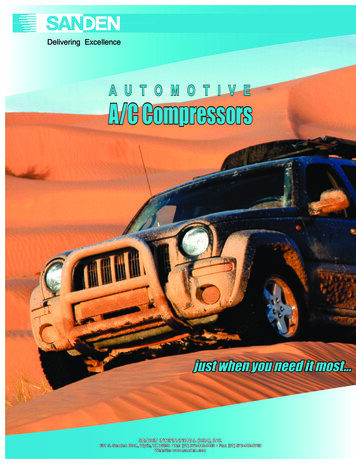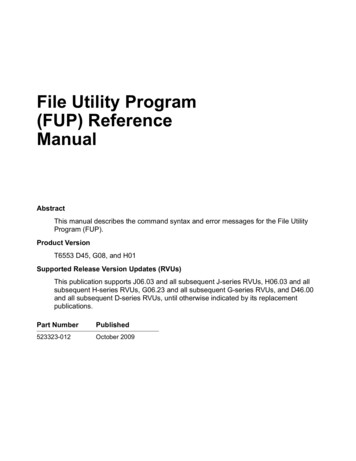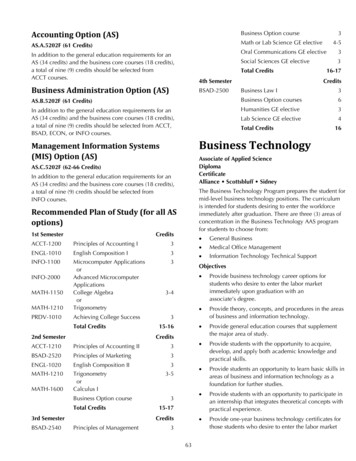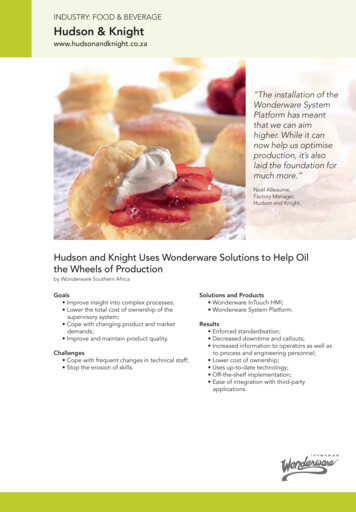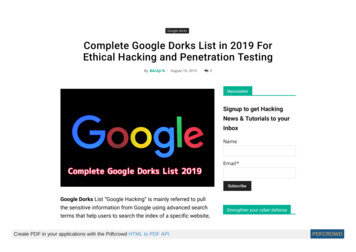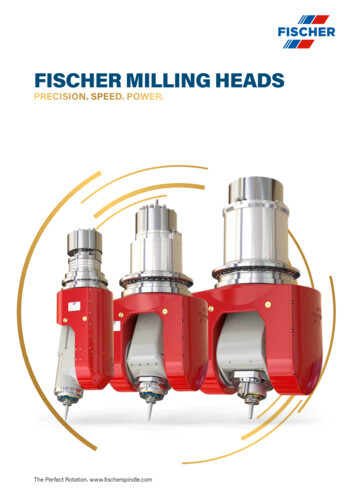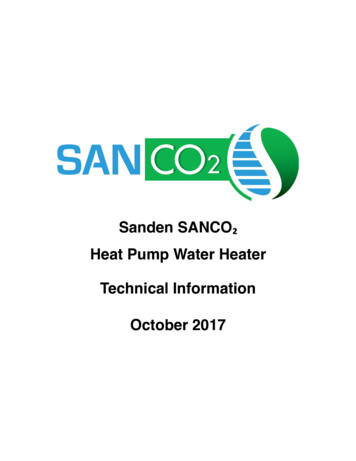
Transcription
Sanden SANCO₂Heat Pump Water HeaterTechnical InformationOctober 2017
SANDEN Technical BookAdvisory note:Basic knowledge of hot water, refrigeration, electricity and thermodynamics is requiredto fully understand this material.Thank you for your attention, the Sanden Technical team.John MilesGeneral ManagerMaho ItoManagerDavid HaleTechnical SupportSanden International (USA), Inc.47772 Halyard Dr.Plymouth MI 48170Phone: 1-844-SANDCO2 / 1-844-726-3236Email: info@sandenwaterheater.comWebsite: www.sandenwaterheater.com2
Table of ContentsPage Number467891011131416172021232432333435TitleAbout SANCO2Applications - ResidentialApplications - Multi-family BuildingsApplications - Light CommercialApplications - Combined SystemUnit OperationRecoveryEfficiency vs AmbientPre-Installation Check ListInstallation TipsFreeze ProtectionRecirculationHeat Pump ModesInside the Heat PumpError CodesMaintenanceWarrantyGlossaryManual Notes3
SANCO2SANCO2 is a customized CO2 Heat Pump Water Heater (HPWH) that Sanden hasdesigned to meet the North American market needs.It is based on the Eco Cute units, which is a widely accepted and commonly used waterheater in Japan and were first introduced to the market in 2001.An Eco Cute is a HPWH that uses carbon dioxide as a refrigerant. “Cute” translates tohot water in Japanese which is pronounced Kyuto.Since 2011, Sanden has collaborated with local utility companies to conduct laboratoryand field testing to ensure that the technology will transfer to the North American marketwithout problems.Why CO2?Carbon dioxide is a unique refrigerant that does not contribute to global warming.The Global Warming Potential (GWP) of carbon dioxide is 1, compared to the GWP ofthe typically used HPWH’s refrigerants such as R134a – GWP of 1,430 and R410a –GWP of 2,086.CO₂ is used as the benchmark to measure Global Warming, so these numbers translatethat 1lb of CO₂ released into the atmosphere will contribute 1lb of Global WarmingPotential, 1lb of R134a will contribute 1,430lbs of Global Warming Potential for 100years.SANCO2 utilizes a 22 oz. of CO2 refrigerant which is charged and stored inside of aclosed loop system with an operating pressure range of 600 psi to 1,600 psi.Carbon dioxide rarely achieves its liquid state. After being compressed and heated, theCO2 refrigerant becomes as dense as liquid, while still remaining as a gas (transcriticalstate), substantially increasing the transfer of heat between itself and the water,especially in low ambient conditions.In addition to the refrigerant attributes mentioned above, carbon dioxide extracts heateven at very low temperatures. The unit operates down below -20 F without a back-upheating element, and will deliver a maximum water temperature of 160 F at those verylow ambient temperatures.4
Cont.Think of it this way – the outside air will transfer heat to the CO2 through an evaporator,the CO2 is then heated through compression, the heat from CO2 is transferred to thecold water through a double wall heat exchanger, and the hot water is pumped from theunit.In the unlikely event of a refrigerant leak, the system can be recharged with CO 2 aswould a normal HVAC system, however we recommend contacting Sanden TechnicalSupport for information on this procedure.What advantages are there?Energy Efficiency- SANCO2 is 4 x more efficient than traditional electric water heaters. It uses muchless energy to heat water faster- SANCO₂ is more efficient in field testing than integrated HPWH’sHigh Performance- Greater first hour rating than all HPWH’s:- 83 Gallon tank – FHR 115 gallons- 43 Gallon tank – FHR 71 gallons- Temperature set-point between 130 and 175 F, delivering hotter water than allother residential electric water heaters- Faster recovery after hot water draw, approximately 18 GPH delivered to the topof the tankExtended Operating Range- Hot water production down to -20 F and below- No need for back up electric element in the storage tankFlexible Installation- Heat Pump is installed outside, so no energy stealing from the space or coldairflow issues to overcome- Tank can be installed almost anywhere in the home, power is not required or alarge space requirement around the tank- Heat pump has an extremely small footprint and a low operating noise levelmaking it suitable for installation almost anywhereHigh Quality with Low Maintenance- Long Life Stainless Steel Tank with a 15 year prorated warranty- No anode rods to replace or air filters to cleanEnvironmentally Friendly- Minimal impact on global warming5
Applications - ResidentialSizingSizing of the system to the home is EXTREMELY IMPORTANT.43 Gallon Tank:First hour delivery (FHR): 71 gallons. This tank size is suitable for families of 2 to 4members.83 Gallon Tank:First hour delivery (FHR): 115 gallons. This tank size is suitable for families of 5 orlarger users of DHW.Heat Pump Outdoor InstallationThe outdoor unit can be installed in various locations including: directly outside of ahome, a garage, basement, mechanical room, or a rooftop.When mounting the unit, ensure no obstacles that can prevent air flow obstruct the unit.If wall mounted installation is desired, the outdoor unit can be installed either high on awall or low on a wall, but should be accessible in the event of maintenance. In areaswith high snowfall, the unit must be installed above the anticipated snowline.Heat pump Indoor InstallationTo remove any ambient issues, locating the condenser inside of a building can be aviable alternative as long as the minimum 800 CFM (cubic feet per minute) ventilationrequirements are met and can be maintained throughout use.Tank InstallationThe Storage tank must be installed upright.Installation clearances are 2” around the tank- no airflow is required so closetinstallation is possible.No power is required for the tank, just water connections to the home and heat pumpplus a control wire connection to the heat pump.Maximum DistanceThe distance between the heat pump and tank must be within the maximum limits of thesystem.Gen3; GS3-45HPA; 50ft total length including 16ft vertical separationGen2; GUS-A45HPA; 25ft total length including 10ft vertical separation6
Applications - Multi-family BuildingsMultiple Units in a Central systemIn most multi-residential applications, multiple heat pump units as well as tank units canbe connected together to increase efficiency, hot water output, and recovery.SizingWhen sizing for multi-residential applications, the following information is required todetermine the number of heat pumps and tanks. Both the heat pump and tank unit arescalable depending on hot water usage.-Number of apartments per buildingNumber of apartments on each floorNumber of bedrooms per apartmentNumber of bathrooms per apartmentNumber of kitchens per floorNumber of laundry rooms per floorExpected number of residents per buildingExpected demography of residents (professional, family, senior)InstallationAs per residential applications, the heat pumps and tanks can be installed indoor and/oroutdoor depending on a building design, location, and climate.Installation location specifics must be as per the residential application.ImportantIt is very important to install multiple heat pumps and tanks using a plumbing schematicdeveloped in consultation with Sanden.Detailed planning and a meticulous installation is required, especially with multiple unitspiped together so that the entire installed system will function as it is intended.7
Applications - Light CommercialSizingThe Sanden heat pump can be used for light commercial applications, such as schools,restaurants, farms and small businesses.The following information is required for water heater sizing:- Daily hot water usage- Peak hot water usage and time- Hot water usage type, for example dish washing, agricultural or hair dressing- List of appliances that use hot water- Number of appliances, bathrooms, shower rooms and kitchens that use hot water- Delivered hot water temperature- Expected hot water draw patternInstallationLike residential applications, heat pumps and tanks can be installed indoor and/oroutdoor depending on a building design, location, and climate.Installation location must be as per the residential application.ImportantIt is very important to install multiple heat pumps and tanks using a plumbing schematicdeveloped in consultation with Sanden.Detailed planning and a meticulous installation is required, especially with multiple unitspiped together so that the entire installed system will function as it is intended.8
Applications – Combination Heating and DHWIt is permitted to use the SANCO2 system to provide some limited capacityheating (radiant, fan coil, etc.) in certain areas of North America, when combinedwith a minimum of 25 gallons per day usage of DHW.It is NOT permitted to use the SANCO2 system to provide heating as its onlyfunction.SizingMaximum heating capacity must be less than 8,000 BTU/h.Minimum design ambient temperature must be above 27 F.Tank size must be the 83 gallon tank.DHW usage – minimum 25 gallons per day.InstallationLike residential applications, the heat pumps and tanks can be installed indoor and/oroutdoor depending on a building design, location, and climate.Installation location specifics must be as per the residential application.ImportantPer your local code, potable and non-potable water may need to be separated. Checkwith your local code authority to determine if separation, and/or use of a double wallheat exchanger is required.In applications requiring separation between potable and non-potable water, Sandenmandates the use of a Taco X-block system.It is very important to install a combination system using the plumbing schematicdeveloped by Sanden.Particular importance must be given to the location of the heating system return waterpipe from the X-block to the tank, lower return water temperatures should return to thebottom of the tank.Detailed planning and a meticulous installation is required, especially with multiple unitspiped together so that the entire installed system will function as it is intended.9
Unit OperationAs hot water is drawn from the top of the tank for showers etc., cold water enters thebottom of the tank from the city or well cold water supply feed.The incoming cold water and stored hot water do not fully mix inside the tank (unlikeother water heaters), this helps maintain a higher average tank temperature and iscalled stratification.As more hot water is drawn from the tank, the volume of cold water increases, howeverthe tank still remains stratified. When the tank temperature sensor measures the watertemperature below 113 F, the heat pump control will start the unit.The variable speed pump pulls the cold water into the heat pump, and using the heatfrom the ambient air the water is heated to the user selected water temperature setpoint and the returned to the top of the tank.Heating continues until the water entering the heat pump heat exchanger is 122 F, atwhich point the heat pump will cycle off and the tank is now completely full of hot water.The SANCO2 unit will produce hot water at temperatures between 130 F and 176 Fdepending on set-point chosen.Therefore, it is mandatory to install the supplied Honeywell AM101 mixing valve and setthe delivered water temperature to the home at the customer’s requirement.10
Hot Water RecoveryThe SANCO₂ system capacity is rated at a minimum of 4.5Kw (15,400 Btu/h) at allambient temperatures above 5 F.Below 5 F, total capacity is reduced, the amount of reduction will depend on the outdoortemperature.Above 5 F, the Hot water recovery for a Sanden system is equivalent to any 4.5Kwelectric water heater, however depending on user set-point selected and incoming watertemperature this recovery rate can alter.This table shows the recovery flow for a single heat pump unit.The flow rate given is the flow from the heat pump to the tank, not flow into thehome/appliance. The recovery rate is the same for an 83 or 43 gallon tank.In multiple heat pump systems, simply multiply the GPH by the number of heat pumpsto calculate system recovery flow.11
Cont.Sanden recommends that the heat pump set-point should be at a minimum of 150 F forthe combination of maximum hot water production and system efficiency.This setting will increase the total delivered recovery of the tank as the hot water fromthe tank will be mixed with cold water to provide the lower delivered water temperatureto the home, to prevent scalding and potential injury.The ratio of hot water and cold water used can be calculated using this formula whichwas developed by ASPE.Heat pump set-point and average tank temperature 150 FIncoming130 F125 F120 F115 FCold iveredDeliveredWater Temp Water Temp Water Temp Water Temp40 F0.820.770.730.6845 F0.810.760.710.6750 F0.800.750.70.6555 F0.790.740.680.6360 F0.780.720.670.61110 FMixedDeliveredWater Temp0.640.620.60.580.56For example:A 3 GPM hot water flow into the home with the mixing valve set for a temperature of120 F, and a cold incoming water temperature of 50 F will need 2.1 GPM of tank waterand 0.9 GPM of cold water.This reduction in water usage from the tank results in greater hot water production fromthe tank and increased recovery rate of the DHW system when viewed as a whole.12
Efficiency, Capacity vs AmbientUnit efficiency is affected by delivered water temperature and outdoor ambientUnit capacity is ONLY affected by outdoor ambient.Annual efficiency can be approximated using the system Coefficient of Performance atthe various ambient temperatures.Coefficient of Performance (COP) is calculated by dividing capacity by power input.As can be seen, at 5 F ambient the system COP over 2.0, which rises to over 4.0 at67 F ambient.13
Pre-Installation Check List1. Unit application sizing and plumbing planningRefer to this manual for information on the sizing and requirements/limitations for thespecific application required.If in doubt, call technical support for advice.2. Electrical RequirementsThe outdoor unit should be fed with mains power from the breaker and local disconnect(per NEC code). Wire sizing should be calculated based on Minimum Circuit Ampacityand wire length.The unit has a 16ft thermistor cable as standard, use a 16-2 AWG shielded wire toextend the thermistor cable from the heat pump unit to the tank.Ensure the breaker size and voltage is correct for the system.Sanden units do not have start components for the compressor, and therefore they relyon the correct power and amperage supply to start:UnitGS3-45HPA-USGUS-A45HPAPower Supply208/230V-1Ph-60Hz208/230V-1Ph-60HzBreaker Size15 Amps15 AmpsVoltage tolerance is 187V to 253V.3. Pipe Length and SizesEnsure that the maximum piping lengths are observed or the system will not operatecorrectly and will likely experience premature failure of its components.Do not upsize or alter the piping length from those published as Sanden cannotguarantee operation with incorrectly installed pipe.For a GS3-A45HPA unit the pipe length should not extend more than 50 feet in lengthwith 16 feet in height or elevation, with a maximum of 6 bends in each pipe run betweenthe tank and heat pump unit.Water supply to the tank, and from the tank to the building MUST be a minimum of ¾”and should be either copper or PEX piping, depending on local code requirementsThe piping size between the heat pump and tank unit MUST be ½” diameter and shouldbe either copper or PEX piping.14
Cont.ALL piping external to the building or in an unconditioned space MUST have a minimum¾” thick closed cell insulation with all joints taped, ensuring none of the system piping isexposed.4. Water QualityWater with high concentrations of chloride that exceed 0.1 ounces per gallon(200mg/litre) can cause corrosion and subsequent failures, and thus the warranty will beno longer valid for the heat pump unit and tank unit.No warranty coverage is given on the heat pump unit and tank unit where the PH is lessthan 6.0.Supply water with a PH less than 6.0 may be treated to raise the PH and it isrecommended that an analysis of the supply water be conducted before connecting theheat pump unit to the system.Changing, or alternating, from one water supply to another can have a detrimental effecton the operation and/or life expectation of the water tank, PR valve, water heatingcirculation and the heat exchanger in the system and should be tested to ensure itmeets the warranty requirements in the installation manual.5. Tank Unit PositioningIf installing the tank unit indoors or in an enclosed space, leave at least 2” of clearancearound the back and sides of the tank.Sanden tanks have all of the connections on the sides of the tank, not the top of thetank like the majority of the North American water heaters.Ensure adequate clearance for the connections and piping to the tank and the piping forthe supplied mixing valve is maintained.6. Outdoor Unit PositioningEnsure that a minimum distance of 6” behind the unit and 12” in front of the unit ismaintained, otherwise, the condenser airflow could be affected. Ensure adequateaccess for service and setting panel operation is provided.Access to the unit can be obtained by removing the top cover and front cover of thecondensing unit and all valve and electrical connections are on the RHS of the outdoorunit when looking at the condenser fan.Sanden recommends a minimum of 18” separation when stacking the units verticallyand 24” for RHS service access.7. Error CodesErrors occur typically because the system has either: too little flow of water from thetank to the heat pump, incorrect voltage to the system, and/or has not been purged ofair in the water on start up.15
Installation TipsCondensateAs the unit is taking heat from the outside air, the coil on the unit will be colder than theambient temperature. This means that depending on the humidity level of the outsideair, the unit will produce condensate as it removes water vapor from the air.The quantity of condensate will depend on the current humidity levelIt is very important that this condensate be drained away from the outdoor unit and theoutdoor unit be raised a minimum of 4” from the ground.This is particularly important in areas exposed to freezing weather as the meltedcondensate from defrost could create a slip and fall hazard.Defrosting of the outdoor coil occurs to remove frost buildup on the coil, the unit willcalculate when to defrost based on operating conditions.The unit is supplied with a 5/8” drain hose connector for a hose to drain away thecondensate (this can be found in the base of the heat pump packaging).Tank ConnectionsAll tank connections are ¾”, this is designed to allow flexibility in the tank installationdue to site conditions.For the heat pump piping, 2 x ¾” to ½” reducers are required.Multiple heat pump systemsFor systems with multiple heat pumps attached to a single tank, every heat pumprequires its own individual thermistor.The thermistor should be securely fitted in the thermistor well and secured with siliconor thermal paste.If using several thermistors, push the first thermistor(s) as deep into the well as it willpossibly go, then follow up by inserting additional thermistor(s).Only one thermistor can go through the terminal block on the tank, with the otherthermistors wired directly to the other heat pump units’ thermistor wire.Existing TanksSanden tanks have been developed to maximize performance and efficiency.For correct unit operation, it is important that the heat pump receives cold water,therefore we do not permit existing water heaters or tanks to be used.16
Freeze ProtectionThe basic design for a Sanden system requires piping potable water to the heat pump.Eco Cute systems are designed to be able to lift water temperatures over 100 F quicklyand efficiently, having a heat exchanger in the storage tank and a closed loop typesystem will significantly reduce performance and efficiency.This results in water being potentially exposed to freezing outdoor temperatures, sostrategies are set up both in installation and the unit control system to minimize thepotential of a freeze-up.1. Minimal Water Piping Outdoors – Plan your job site and unit location topenetrate into the building adjacent to the heat pumpUse ¾” minimum thick closed cell insulation on the external pipingTape joints and ensure that none of the system piping is exposed2. Control Logic – Two stages of freeze protection built into the control logic.Stage 1;Unit measures Inlet water temperature or outlet water temperaturebelow 39 F (4 C), with an outside air temperature less than 30 F (-1 C)Stage 2;If the outside air temperature is at or below the temperatures in thetable below, freeze protection will be triggered based on timing, not inlet & outletwater temperatures.Timing starts once the compressor has cycled off in normal operation, unlesspower is lost to the unit, in which case the timing will restart at zero when poweris restored.When the freeze protection cycle starts initially the water pump will operate, thenthe compressor will start 3 minutes later.Water will be heated to the set-point temperature and the compressor willcontinue to operate until the return water to the heat exchanger reaches 122 F.Once the compressor stops the timing will begin again and based on the ambienttemperature freeze protection will begin again after the appropriate time periodhas passed.17
3. Trace Heat - To protect the piping between the tank and heat pump, werecommend that trace heat be installed in applications where the winter designambient is below 30 F.Self-regulating trace heat 6W per foot is recommended.Sanden provides as an optional extra a 6ft length of trace heat cable,Part # FG2-6L.This length is designed to install on both the hot and cold water pipes attached tothe unit and connected to the mains voltage wiring for the unit.The Sanden trace heat cable selected will regulate based on the exacttemperature down to the inch that the cable senses.Sanden recommends that the trace heat cabling start at the top connection set,then wrap around the hot water supply piping (under the insulation) and crossover to the cold water inlet piping inside the building (minimizes the length ofcable exposed to the air, then finish at the bottom connection set.Follow the instructions provided in the trace heat kit for detailed information onthe cable instruction.Field testing has shown that when correctly installed, self-regulating trace heatwill use less than 0.3% of the total energy consumed by the Sanden unit.Trace Heat Cable Construction & Technology18
4. Power OutageIf the mains power is cut to the system for whatever reason, it is acceptable torun the unit using a generator.The unit will consume a maximum of approximately 2.5kw at -20 F ambient, soensure that the generator is sized correctly.However, without backup power there is a risk of the 0.6 gallons of watercontained in the outdoor unit and the approximate maximum of 1 gallon of waterin the interconnect piping may freeze.Sanden has conducted tests where the unit has been left without power for 24hours in a 25 F ambient and no freezing was reported.The water in the outdoor unit and piping can be drained manually using the airbleed screws, however the tank will need to be isolated before draining.An automatic system based on a drain back philosophy is available using threesolenoid valves and a vacuum breaker to both isolate the tank and to drain downthe outdoor unit and piping on power being cut.19
RecirculationThese types of systems are often used to ensure hot water is available at the furthestfixture from the storage tank.Multiple types of recirculation systems are available commercially.Sanden only permits the use of systems that use either a sensor or an aquastat tocontrol the pump. Timer systems are not permitted.The recirculation system should only operate to clear the plug of cold water from thepiping, typically this plug is less than 2 gallons in a residential application.For commercial recirculation applications – please contact technical support.Pipe SizeWater Volume per Foot of pipeWater Volume per 50ft of pipe½”¾”1”0.010.020.040.51.22.120
Heat Pump Control ModesTime SettingAs part of the water heating cycle logic refers to the current time, it is necessary to setthe clock on the controller before starting to use the product.Commissioning ModeAfter the mode is selected, press the Enter key to select an option mode from the fivemodes described below.Heat Setting ModeSet the heating mode to either ON (unit runs) or OFF (unit cannot operate).Temperature Setting ModeThe water temperature settings available are 130 F, 140 F, 150 F, 160 F, 165 F and175 F (55 C, 60 C, 65 C, 70 C, 75 C and 80 C)Block Out Time SettingThis mode is used to set a single block out time that prevents the heat pump unitoperation within that chosen time period.Error HistoryThis records all errors that have occurred on the system and can be used fortroubleshooting after an error code has been cleared by cycling the power to the unit.Parameter DisplayThis displays all of the values currently measured by the unit’s temperature sensors andcan be used for troubleshooting and general unit performance questions.Setting Panel LocationThe setting panel is located under the top cover and the display can be viewed throughthe window above the water fitting side of the heat pump and is used to navigate andselect between the modes listed above.21
Cont.DOWN is reverseHold down UP andDOWN togetherDisplay Sleep ModeAny KeyNo Operationfor 60sec.Clock Display ModeEnterPress andhold down EnterorEnterNo Operationorfor 60sec.No Operationfor 60sec.EnterHeat Setting ModeUPEnterOutlet water Temp Setting ModeUPEnterBlockout Time Setting ModeUPEnterError History Display ModeUPEnterParameter Display ModeUPClock Setting ModeParametersIn the parameter mode, the system will display control values used by the unit.When a temperature value is displayed, it will show as C x 10 for example 0580 58 Cor when converted 136 F. To convert use this formula; F ( C x 1.8) 3222
Inside the Heat PumpVariable Speed FanThe fan speed is based on the ambient temperature for maximum capacity & efficiency.Water PumpWater flow is controlled by a variable speed water pump located inside the heat pump,the flow rate is varied to maintain the set-point supply temperature.PCBThe PCB constantly monitors and adjusts the operation of the heat pump to maintaincapacity, efficiency and reliabilitySetting/Operation PanelUsed to navigate through each setting for the heat pump unit.23
Error CodesOutdoor Unit Self DiagnosisThe outdoor unit has a built-in self-diagnostic system that will register 82 different faultsbased on the sensors and control logic of the outdoor unit.The setting panel on the unit will display the numerical value of the error code with a redlight. All of the error codes are listed in the Installation and Owners Manuals providedwith the unit- and cause the heat pump to shut down simultaneously.Inadequate FlowRestricted water flow to and from the heat pump will ultimately result in an error code.If this issue arises, make sure the pipe size is correct, the pipe length/lift is inside themaximum, check the heat pump piping for blockage or kinking, look for freezing if in acold climate, ensure all water shut off valves are open, and ensure water is supplied tothe system from the building.System CommunicationA system control error show up occasionally on a heat pump unit.For a communication/system control error - Error Code 40 to 82 – perform the followingchecks:- Check that all wire connections are firmly attached to the PCB.- Check the unit for proper voltage at various points.Clearing ErrorsTo clear an error code after it has been corrected, turn off power to the unit and wait 3minutes before restarting.The error code will now be accessible in the Error History mode.24
Error E034Error ExplanationNo error code reportedHP Water Outlet Over Temperature 1HP Water Outlet Over Temperature 2HP Outlet Temp thermistor detection errorHP Discharge Over Temperature 1HP Discharge Over Temperature 2HP Discharge Temperature Thermistor detection errorHigh Pressure ErrorHigh Ambient Temperature Defrost Drive errorHP Defrost thermistor detection errorHP Inlet Temp thermistor wire break or reading value -22 FHP Outlet Temp thermistor wire break or reading value -22 FHP Discharge temp thermistor wire break or reading value -24 FHP Defrost thermistor wire break or reading value -58 FHP Ambient Temp thermistor wire break or reading value -58 FTank thermistor wire break or reading value -22 FHP Inlet Temp thermistor wire break or reading value 212 FHP Outlet Temp thermistor short circuit or reading value 302 FHP Discharge thermistor short circuit or reading value 302 FHP Defrost Temp thermistor short circuit or reading value 212 FHP Ambient Temp thermistor wire break or reading value 212 FTank thermistor short circuit or reading value 248 FFan Motor LockedFan Motor Revolution errorWater Pump locked25
Error 59E060E061E062E063E064E065E066E080E081E082Error ExplanationINV Compressor Start errorINV Communication errorINV Transient Over Current error at ConverterINV Transient Over Current error at InverterINV Transient Over Current Software error at InverterINV Transient Over Current Software error at ConverterINV Temperature Sensor errorINV Heatsink Temperature errorINV Overload Detection errorINV Power Supply Low Voltage errorINV Power Supply Over Voltage errorINV Inverter Current Detection errorINV Transient Power Cutoff Detection errorINV Transient Power Cut off Detection error 1INV Transient Power Cut off Detection error 2INV Control
The following information is required for water heater sizing: - Daily hot water usage - Peak hot water usage and time - Hot water usage type, for example dish washing, agricultural or hair dressing . heating (radiant, fan coil, etc.) in certain areas of North America, when combined with a minimum of 25 gallons per day usage of DHW.
